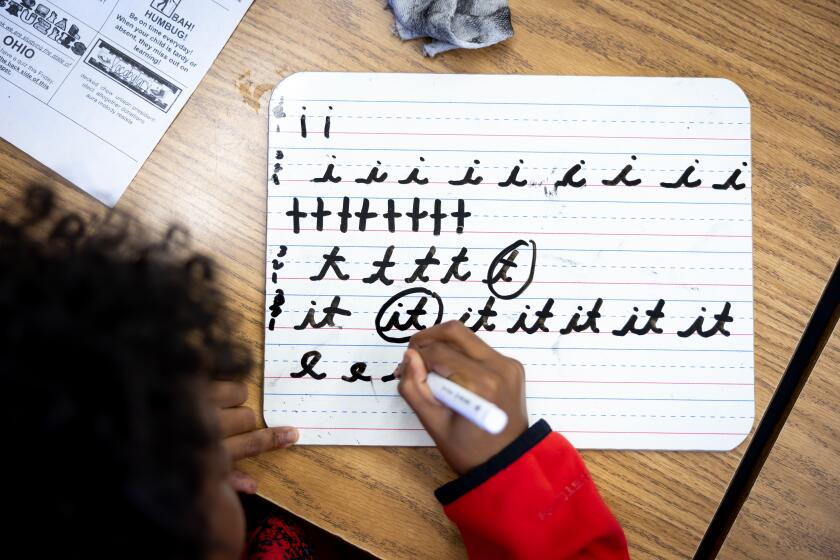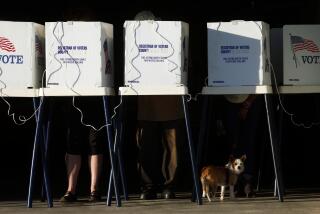“Most people my age just kind of scribble.” Signatures were a sticking point for young California voters this year

- Share via
- For young Americans, a written signature doesn’t mean much anymore — except when voting by mail, when a signature is critical to determining whether a ballot is counted.
- In California, voters younger than 25 made up 10% of the November electorate, but had nearly 3 in 10 of the ballots set aside for signature issues, according to a new survey.
More than a month after voting by mail in the presidential election, South Los Angeles resident Taylor Johnson learned that his vote had not been counted because election workers had taken issue with the way he signed his name on the ballot envelope.
The elections office told Johnson that his ballot signature didn’t match another signature they had on file. Johnson wasn’t sure which signature that was, but he knew it would have looked different: After printing his name for years, he perfected his cursive signature only a few months ago.
“Most people my age just kind of scribble,” said Johnson, 20, who works as an administrative assistant at a medical imaging clinic.
For young Americans who rarely sign anything beyond a paper receipt or a coffee shop iPad, a written signature just doesn’t mean much anymore — except when voting by mail, when a signature is crucial to determining whether a mail ballot is counted.
Teaching of cursive writing returns after falling to the wayside amid revised learning standards and emphasis on keyboarding. Backers say it promotes learning.
In California, voters younger than 25 made up 10% of the November electorate, but had nearly 3 in 10 of the ballots set aside for signature issues, according to an analysis by voter data firm Political Data Inc. More than half of the state’s ballots with signature issues were from voters younger than 35.
California generally verifies the identities of mail-in voters through their signatures. As many as three election workers scrutinize each ballot envelope to ensure the signature matches the voter’s registration paperwork or driver’s license, and set aside envelopes with missing or mismatched signatures.
Election officials are required to notify those voters and give them an opportunity to fix the error.
In the November election, nearly 200,000 ballots were flagged for signature issues across California’s 58 counties. Nearly 6 in 10 were eventually counted through a process known as curing, in which a voter can fill out a form to attest that the flawed ballot was theirs, while more than 83,000 were not counted.
In a survey of voters whose ballots were flagged because of signature problems, 40% of respondents said their signature looked different than it used to, another 40% said they used a sloppy, incomplete or casual signature, “like one I use signing a restaurant bill,” and 12% said they forgot to sign the envelope.
“When you’re dealing with a state with 22 million voters, and 16 million sending their ballots in with signatures, there’s a multitude of ways that some little nonsensical thing can create a problem,” said Paul Mitchell, a vice president at PDI who conducted the survey.
Orange County Registrar of Voters Bob Page recommended that voters look at the signature on their driver’s license before signing their ballots and should consider sending in a new registration form if their signature has changed. He said Orange County plans to send forms to 12,000 voters in hopes of getting a new signature on file.
“We know that signatures change over time,” Page said. “And we know that the way people sign at the little pad with their finger at the DMV is not how they really sign their names.”
Mitchell’s analysis found that in the state’s six most competitive congressional races, 85% of Republicans and Democrats whose ballots were flagged for signature issues were able to cure their ballots and have their votes counted, a 25-point jump over statewide averages.
The Republican and Democratic parties had armies of volunteers and staff members to go door to door in the most competitive U.S. House of Representatives districts.
Democrats flipped Republican-held congressional seats in Orange County, the Central Valley and northern L.A. County, helping lead the party in narrowing the GOP House majority.
In the Central Valley, where Democrat Adam Gray narrowly bested GOP Rep. John Duarte, the number of ballots cured by Democrats and Republicans far outstripped the 187-vote margin of the race.
Campaign volunteers and workers went door to door in the districts, trying to talk to voters in person and explaining how to complete the ballot paperwork, in some cases helping them navigate scanning in, printing out and returning the forms.
Mitchell found that voters with no party preference had a far lower rate of return than voters affiliated with the Republican and Democratic parties in competitive swing districts, suggesting that each party was focusing on their most loyal voters first.
In less competitive districts, voters were more on their own.
Cassidy Crotwell, 22, registered to vote during an economics class in her senior year at El Toro High School in Orange County. Everyone in the class registered on their phones, she said, and she didn’t sign anything.
Crotwell learned about the issue with her November ballot signature through a text message from the Orange County Registrar’s office. Republican Rep. Young Kim, who represents her Congressional district, easily won reelection, and neither party mounted a meaningful curing operation there; no other groups or campaigns contacted Crotwell, she said.
She assumed the elections office had a signature on file from when she got her driver’s license at age 16, but her signature is “a little more defined now,” she said — the result of a job in human resources where she signs a lot of paperwork. She didn’t end up fixing her ballot but plans to update her signature the next time she goes to the DMV.
Johnson, the South L.A. voter, did not fix his ballot, either. By the time he learned his vote hadn’t been counted, the presidential election had been over for weeks.
In the 2026 midterms, Johnson said, he’s going to vote in person — no signature required.
More to Read
Get the L.A. Times Politics newsletter
Deeply reported insights into legislation, politics and policy from Sacramento, Washington and beyond. In your inbox three times per week.
You may occasionally receive promotional content from the Los Angeles Times.













